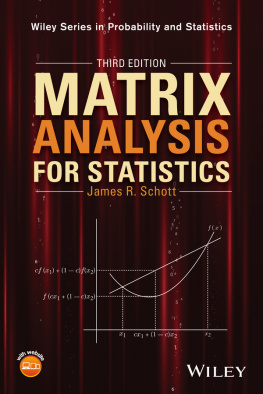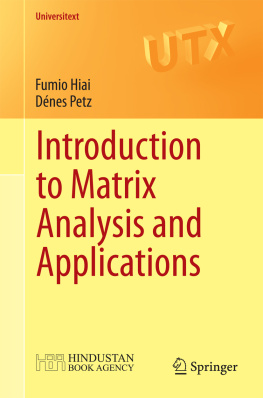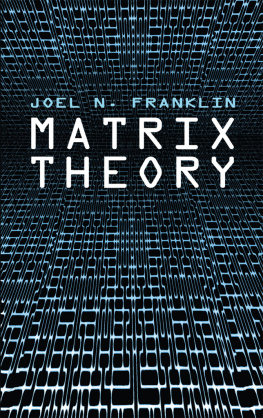James R. Schott - Matrix Analysis for Statistics: Third Edition
Here you can read online James R. Schott - Matrix Analysis for Statistics: Third Edition full text of the book (entire story) in english for free. Download pdf and epub, get meaning, cover and reviews about this ebook. year: 2015, genre: Romance novel. Description of the work, (preface) as well as reviews are available. Best literature library LitArk.com created for fans of good reading and offers a wide selection of genres:
Romance novel
Science fiction
Adventure
Detective
Science
History
Home and family
Prose
Art
Politics
Computer
Non-fiction
Religion
Business
Children
Humor
Choose a favorite category and find really read worthwhile books. Enjoy immersion in the world of imagination, feel the emotions of the characters or learn something new for yourself, make an fascinating discovery.
- Book:Matrix Analysis for Statistics: Third Edition
- Author:
- Genre:
- Year:2015
- Rating:3 / 5
- Favourites:Add to favourites
- Your mark:
- 60
- 1
- 2
- 3
- 4
- 5
Matrix Analysis for Statistics: Third Edition: summary, description and annotation
We offer to read an annotation, description, summary or preface (depends on what the author of the book "Matrix Analysis for Statistics: Third Edition" wrote himself). If you haven't found the necessary information about the book — write in the comments, we will try to find it.
Matrix Analysis for Statistics: Third Edition — read online for free the complete book (whole text) full work
Below is the text of the book, divided by pages. System saving the place of the last page read, allows you to conveniently read the book "Matrix Analysis for Statistics: Third Edition" online for free, without having to search again every time where you left off. Put a bookmark, and you can go to the page where you finished reading at any time.
Font size:
Interval:
Bookmark:

WILEY SERIES IN PROBABILITY AND STATISTICS
Established by WALTER A. SHEWHART and SAMUEL S. WILKS
Editors: David J. Balding, Noel A. C. Cressie, Garrett M. Fitzmaurice, Geof H. Givens, Harvey Goldstein, Geert Molenberghs, David W. Scott, Adrian F. M. Smith, Ruey S. Tsay, Sanford Weisberg
Editors Emeriti: J. Stuart Hunter, Iain M. Johnstone, Joseph B. Kadane, Jozef L. Teugels
A complete list of the titles in this series appears at the end of this volume.
Copyright 2017 by John Wiley & Sons, Inc. All rights reserved
Published by John Wiley & Sons, Inc., Hoboken, New Jersey
Published simultaneously in Canada
No part of this publication may be reproduced, stored in a retrieval system, or transmitted in any form or by any means, electronic, mechanical, photocopying, recording, scanning, or otherwise, except as permitted under Section 107 or 108 of the 1976 United States Copyright Act, without either the prior written permission of the Publisher, or authorization through payment of the appropriate per-copy fee to the Copyright Clearance Center, Inc., 222 Rosewood Drive, Danvers, MA 01923, (978) 750-8400, fax (978) 750-4470, or on the web at www.copyright.com. Requests to the Publisher for permission should be addressed to the Permissions Department, John Wiley & Sons, Inc., 111 River Street, Hoboken, NJ 07030, (201) 748-6011, fax (201) 748-6008, or online at http://www.wiley.com/go/permissions.
Limit of Liability/Disclaimer of Warranty: While the publisher and author have used their best efforts in preparing this book, they make no representations or warranties with respect to the accuracy or completeness of the contents of this book and specifically disclaim any implied warranties of merchantability or fitness for a particular purpose. No warranty may be created or extended by sales representatives or written sales materials. The advice and strategies contained herein may not be suitable for your situation. You should consult with a professional where appropriate. Neither the publisher nor author shall be liable for any loss of profit or any other commercial damages, including but not limited to special, incidental, consequential, or other damages.
For general information on our other products and services or for technical support, please contact our Customer Care Department within the United States at (800) 762-2974, outside the United States at (317) 572-3993 or fax (317) 572-4002.
Wiley also publishes its books in a variety of electronic formats. Some content that appears in print may not be available in electronic formats. For more information about Wiley products, visit our web site at www.wiley.com.
Library of Congress Cataloging-in-Publication Data:
Names: Schott, James R., 1955- author.
Title: Matrix analysis for statistics / James R. Schott.
Description: Third edition. | Hoboken, New Jersey : John Wiley & Sons, 2016. | Includes bibliographical references and index.
Identifiers: LCCN 2016000005| ISBN 9781119092483 (cloth) | ISBN 9781119092469 (epub)
Subjects: LCSH: Matrices. | Mathematical statistics.
Classification: LCC QA188 .S24 2016 | DDC 512.9/434-dc23 LC record available at http://lccn.loc.gov/2016000005
Cover image courtesy of GettyImages/Alexmumu.
To Susan, Adam, and Sarah
As the field of statistics has developed over the years, the role of matrix methods has evolved from a tool through which statistical problems could be more conveniently expressed to an absolutely essential part in the development, understanding, and use of the more complicated statistical analyses that have appeared in recent years. As such, a background in matrix analysis has become a vital part of a graduate education in statistics. Too often, the statistics graduate student gets his or her matrix background in bits and pieces through various courses on topics such as regression analysis, multivariate analysis, linear models, stochastic processes, and so on. An alternative to this fragmented approach is an entire course devoted to matrix methods useful in statistics. This text has been written with such a course in mind. It also could be used as a text for an advanced undergraduate course with an unusually bright group of students and should prove to be useful as a reference for both applied and research statisticians.
Students beginning in a graduate program in statistics often have their previous degrees in other fields, such as mathematics, and so initially their statistical backgrounds may not be all that extensive. With this in mind, I have tried to make the statistical topics presented as examples in this text as self-contained as possible. This has been accomplished by including a section in the first chapter which covers some basic statistical concepts and by having most of the statistical examples deal with applications which are fairly simple to understand; for instance, many of these examples involve least squares regression or applications that utilize the simple concepts of mean vectors and covariance matrices. Thus, an introductory statistics course should provide the reader of this text with a sufficient background in statistics. An additional prerequisite is an undergraduate course in matrices or linear algebra, while a calculus background is necessary for some portions of the book, most notably, .
By selectively omitting some sections, all nine chapters of this book can be covered in a one-semester course. For instance, in a course targeted at students who end their educational careers with the masters degree, I typically omit Sections 2.10, 3.5, 3.7, 4.8, 5.4-5.7, and 8.6, along with a few other sections.
Anyone writing a book on a subject for which other texts have already been written stands to benefit from these earlier works, and that certainly has been thecase here. The texts by Basilevsky (1983), Graybill (1983), Healy (1986), and Searle (1982), all books on matrices for statistics, have helped me, in varying degrees, to formulate my ideas on matrices. Graybill's book has been particularly influential, since this is the book that I referred to extensively, first as a graduate student, and then in the early stages of my research career. Other texts which have proven to be quite helpful are Horn and Johnson (1985, 1991), Magnus and Neudecker (1988), particularly in the writing of , and Magnus (1988).
I wish to thank several anonymous reviewers who offered many very helpful suggestions, and Mark Johnson for his support and encouragement throughout this project. I am also grateful to the numerous students who have alerted me to various mistakes and typos in earlier versions of this book. In spite of their help and my diligent efforts at proofreading, undoubtedly some mistakes remain, and I would appreciate being informed of any that are spotted.
Jim Schott
Orlando, Florida
The most notable change in the second edition is the addition of a chapter on results regarding matrices partitioned into a 22 form. This new chapter, which is of the first edition. Along with the results on the determinant and inverse of a partitioned matrix, I have added new material in this chapter on the rank, generalized inverses, and eigenvalues of partitioned matrices.
The coverage of eigenvalues in of the first edition has now been replaced by two sections.
Other smaller additions, including both theorems and examples, have been made elsewhere throughout the book. Over 100 new exercises have been added to the problems sets.
The writing of a second edition of this book has also given me the opportunity to correct mistakes in the first edition. I would like to thank those readers who have pointed out some of these errors as well as those that have offered suggestions for improvement to the text.
Next pageFont size:
Interval:
Bookmark:
Similar books «Matrix Analysis for Statistics: Third Edition»
Look at similar books to Matrix Analysis for Statistics: Third Edition. We have selected literature similar in name and meaning in the hope of providing readers with more options to find new, interesting, not yet read works.
Discussion, reviews of the book Matrix Analysis for Statistics: Third Edition and just readers' own opinions. Leave your comments, write what you think about the work, its meaning or the main characters. Specify what exactly you liked and what you didn't like, and why you think so.






![James D. Miller [James D. Miller] - Statistics for Data Science](/uploads/posts/book/119637/thumbs/james-d-miller-james-d-miller-statistics-for.jpg)


